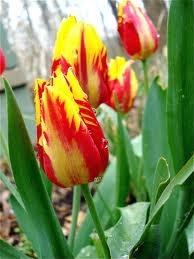-
Tulips originated in Asia, and when they arrived in Europe in the 16th century, they became status symbols, sometimes costing the equivalent of $2,000 per bulb. Today, gardeners no longer have to take out a second mortgage in order to plant a bed of tulips, but the brilliantly hued early-spring arrivals remain popular garden plants. How you classify tulips depends on whether you approach the flower as a gardener or a botanist.
Bulbs
-
Gardeners plant and refer to tulips as bulbs. Bulbs are not the same as seeds; rather, they act as underground food storage structures that allow the plant to survive the winter and that power new growth in the spring. Bulbs constantly produce new underground offshoots, meaning that over the years, you can acquire a bed full of tulips. More specifically, tulips belong to the classification of tunicate bulbs, those covered by a protective, papery coating. Gardeners also refer to tulips as hardy bulbs, meaning that they can withstand cold winter temperatures. In fact, tulips require cold temperature in order to bloom, and gardeners in mild climates must dig them up and refrigerate them in order to get a second season of bloom.
Flowering Plants
-
Within the plant kingdom, botanists place species into divisions based on their structure and manner of reproduction. Tulips belong to the broad division known as the angiosperms, or flowering plants, the largest and most diverse division within the plant kingdom. Angiosperms produce seeds inside of flowers rather than leaving them exposed on the outside of the plant.
Liliaceae
-
Within the flowering plant division, tulips belong to the lily family, a diverse family that contains more than 3,500 species that include members such as as aloe and onions. Members of the lily family tend to have soft, not woody, tissue and return perennially to your garden, a feat made possible through the use of underground storage structures, like the tulip bulb. Family members grow narrow leaves with parallel veins.
Tulipa
-
Within the lily family, botanists and taxonomists classify all tulip species in the genus Tulipa, a word derived from the Turkish word meaning turban and referring to the tulip’s showy cup- or bell-shaped blossoms. Members of the genus also have long, lance-shaped leaves and overwinter as bulbs.
Early- to Late-Blooming
-
Gardeners classify tulips within the Tulipa genus based on the time of the year when the plants bloom. Very early-blooming varieties begin blooming in early spring, during late March to early April. Early and midseason varieties bloom in three-week intervals after that, and the tulip season ends with the late-blooming varieties, which bloom in mid- to late May.


Deprecated: strpos(): Passing null to parameter #1 ($haystack) of type string is deprecated in /home/agriviek8Qv/agriviet.net/public_html/wp-includes/comment-template.php on line 2522